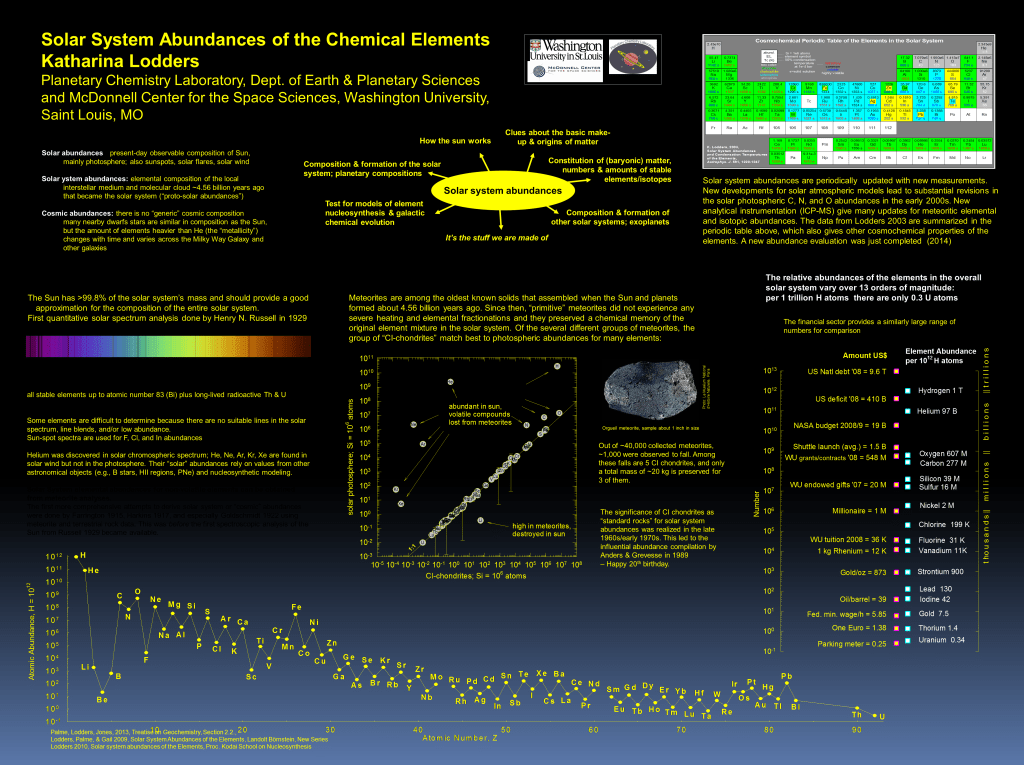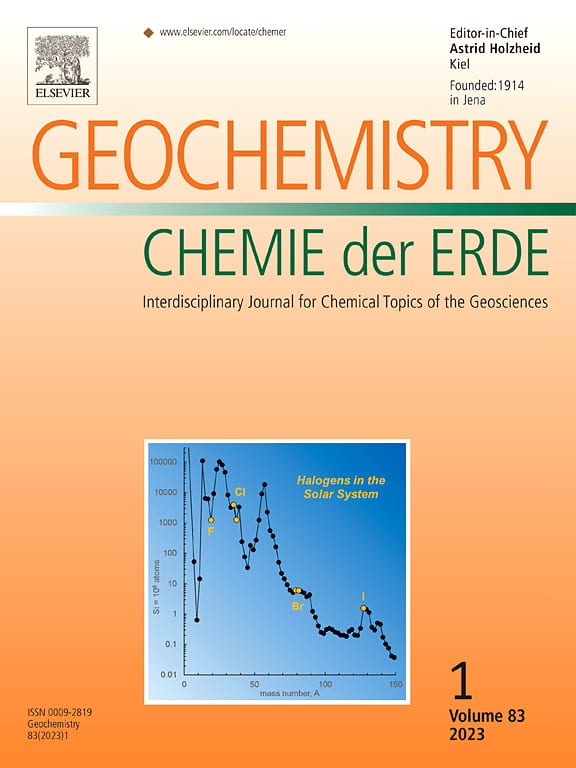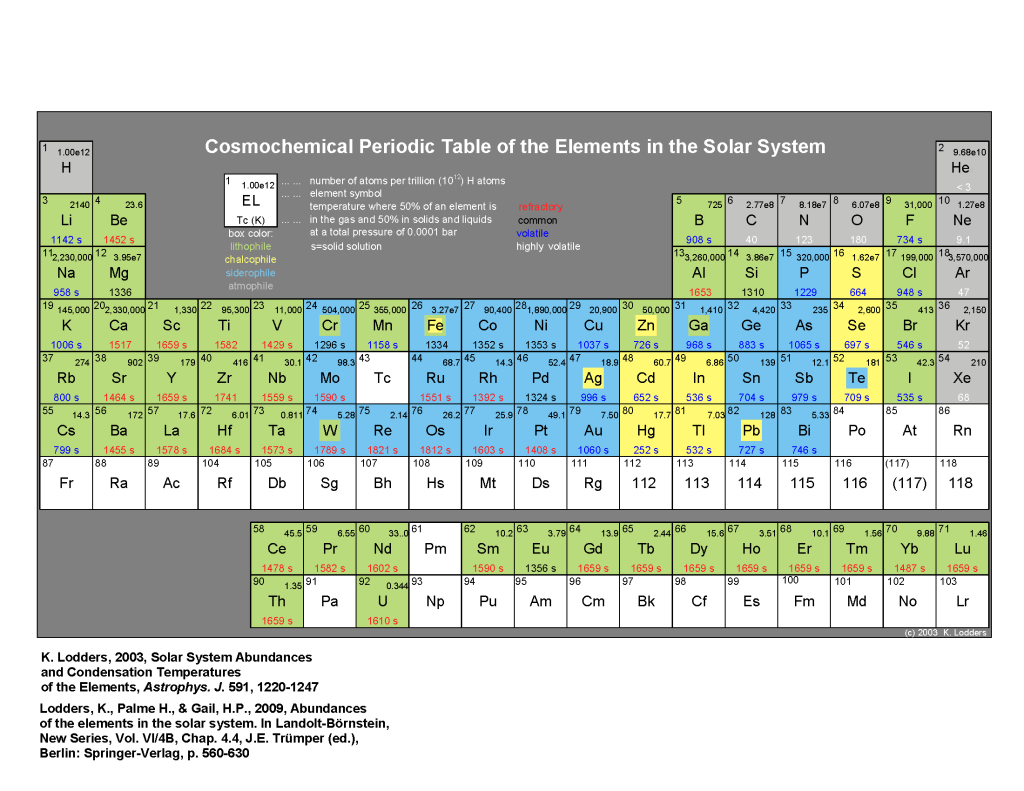

Lodders, K., Fegley B. 2023. Solar system abundances and condensation temperatures of the halogens fluorine, chlorine, bromine, and iodine. Geochemistry 83, 125957. DOI 10.1016/j.chemer.2023.125957. Preprint
Lodders, K. 2021. Relative atomic solar system abundances, mass fractions, and atomic masses of the elements and their isotopes, composition of the solar photosphere, and compositions of the major chondritic meteorite groups. Space Science Reviews 217, id 44. Also in: Proc. ISSI Workshop on Reading Terrestrial Planet Evolution in Isotopes and Element Measurements. Eds. H Lammer, B. Marty, A.L. Zerkle, M. Blanc, H. O’Neill, T. Kleine. Berlin: Springer, Publisher’s link: https://link.springer.com/content/pdf/10.1007/s11214-021-00825-8.pdf1. Preprint.
Lodders, K. 2020 Solar Elemental Abundances, in The Onlibe Oxford Research Encyclopedia of Planetary Science, Oxford University Press. DOI: https://doi.org/10.1093/acrefore/9780190647926.013.145. See also: 2019arXiv191200844L
2020, 2021: Abundances Data Tables

Bermingham, K.R., Füri, E., Lodders, K., Marty, B. 2020, The NC-CC Isotope Dichotomy: Implications for the Chemical and Isotopic Evolution of the Early Solar System, Space Science Reviews 216(8), id133. Also in: Proceedings ISSI Workshop on Reading Terrestrial Planet Evolution in Isotopes and Element Measurements, Bern, Switzerland 22-26 October 2018 (invited). Eds. H Lammer, B. Marty, A.L. Zerkle, M. Blanc, H. O’Neill, T. Kleine, Berlin: Springer. 10.1007/s11214-020-00748-w
Lodders, K. 2020. The cosmic lithium story. Elements Magazine 16, 241-246, https://doi.org/10.2138/gselements.16.4.241

K. Lodders, H. Palme, H.-P. Gail 2009, Abundances of the elements in the solar system. In: Landolt-Börnstein, New Series, Vol. VI/4B, Chap. 4.4, J. E. Trumper (ed.), Springer Verlag, Berlin. 560-630. reprint
K. Lodders 2003, Solar System Abundances and Condensation Temperatures of the Elements. Astrophys. J. 591, 1220-1247. reprint, Table 1, Table 2, Table 3, Table 6, Table 8, Table 9
Cosmochemical Periodic Table of the Elements in the Solar System (PDF)
Lodders, K. 2008, The solar argon abundance, Astrophys. J. 674(1), 607-611. reprint
K. Lodders 2004, Jupiter Formed with More Tar than Ice, ApJ, 611, 587-597. reprint
B. Fegley, Jr. 2000, Cosmochemistry, in Oxford Companion to the Earth, (Hancock, P. L and Skinner, B. J., eds.) Oxford University Press, Oxford, UK, pp. 182-185. reprint
W. M. Irvine, F. P. Schloerb, J. Crovisier, B. Fegley, Jr., and M. J. Mumma 2000, Comets: A Link between Interstellar and Nebular Chemistry, in Protostars and Planets IV, University of Arizona Press, Tucson, AZ, pp. 1159-1200. reprint
A. N. Krot, B. Fegley Jr., H. Palme, and K. Lodders 2000, Meteoritical and Astrophysical Constraints on the Oxidation State of the Solar Nebula, in Protostars and Planets IV, University of Arizona Press, Tucson, AZ, pp. 1019-1054. reprint
B. Fegley, Jr. 2000, Kinetics of Gas-Grain Reactions in the Solar Nebula, Space Sci. Rev. 92, 177-200. reprint
T. R. Ireland and B. Fegley, Jr. 2000, The Solar System’s Earliest Chemistry: Systematics of Refractory Inclusions, International Geology Review42, 865-894. reprint
K. Lodders 1998, A Survey of SNC-Meteorite Whole Rock Compositions. Meteoritics & Planet. Sci. 33, A183-A190. reprint
K. Kitts and K. Lodders 1998, Survey and Evaluation of Eucrite Bulk Compositions. Meteoritics & Planet. Sci. 33, A197-A213. reprint
Y. Hong and B. Fegley, Jr. 1998, Experimental Studies of Magnetite Formation in the Solar Nebula. Meteoritics & Planet. Sci. 33, 1101-1112. reprint
D. S. Lauretta, K. Lodders, and B. Fegley, Jr. 1998, Kamacite Sulfurization in the Solar Nebula. Meteoritics & Planet. Sci. 33, 821- 834. reprint
B. Fegley, Jr. 1997, Cosmochemistry, in Encyclopedia of Planetary Sciences, (J.H. Shirley & R.W. Fairbridge, eds.) Chapman & Hall, London, pp. 169-177. reprint
D. S. Lauretta, K. Lodders, B. Fegley, Jr., and D. T. Kremser 1997, The Origin of Sulfide-Rimmed Metal Grains in Ordinary Chondrites. Earth Planet. Sci. Lett. 151, 289-301. reprint
D. S. Lauretta and K. Lodders 1997, The Cosmochemical Behavior of Beryllium and Boron. Earth Planet. Sci. Lett. 146, 315-327. reprint
D. S. Lauretta, K. Lodders, and B. Fegley, Jr. 1997, Experimental Simulations of Sulfide Formation in the Solar Nebula. Science277, 358-360. reprint
D. S. Lauretta, D. T. Kremser, and B. Fegley, Jr. 1996, The Rate of Iron Sulfide Formation in the Solar Nebula, Icarus 122, 288-315. reprint
D. S. Lauretta, D. T. Kremser, and B. Fegley, Jr. 1996, A Comparative Study of Experimental and Meteoritic Sulfide Assemblages, Proc. NIPR Symp. Antarct. Meteorites 9, 97-110, Tokyo, Japan. reprint
D. S. Lauretta, B. Fegley, Jr., K. Lodders, and D. T. Kremser 1996, The Kinetics and Mechanism of Iron Sulfide Formation in the Solar Nebula, Proc. NIPR Symp. Antarct. Meteorites 9, 111-126, Tokyo, Japan. reprint
K. Lodders 1996, An Experimental and Theoretical Study of Rare Earth Element Partitioning Between Sulfides (FeS, CaS) and Silicate and Applications to Enstatite Achondrites. Meteoritics & Planet. Sci., 31, 749-766. reprint
K. Lodders 1996, Oldhamite in Enstatite Achondrites (aubrites). Proc. NIPR Symp. Antarct. Meteorites 9, 127-142, Tokyo, Japan. reprint
S. R. Jurewicz, J. H. Jones, and B. Fegley, Jr. 1995, Experimental Partitioning of Zirconium, Niobium, and Titanium between Platinum Group Metals and Silicate Liquid: Implications for the Origin of Refractory Metal Nuggets in Carbonaceous Chondrites. Earth Planet. Sci. Lett.132, 183-198. reprint
B. Fegley, Jr. 1993, Chemistry of the Solar Nebula, in The Chemistry of Life’s Origins, ed., M. Greenberg, C. X. Mendoza-Gomez, and V. Pirronello, NATO Advanced Science Institute, Series C vol. 416, Kluwer Academic Publishers, Dordrecht, Netherlands, pp. 75-147. reprint
K. Lodders and B. Fegley, Jr. 1993, Lanthanide and Actinide Chemistry at High C/O Ratios in the Solar Nebula. Earth Planet. Sci. Lett.117, 125-145. reprint
K. Lodders, H. Palme, and F. Wlotzka 1993, Trace Elements in Mineral Separates of the Pena Blanca Spring Aubrite: Implications for the Evolution of the Aubrite Parent Body. Meteoritics 28, 538-551. reprint
B. Fegley, Jr. and T. R. Ireland 1991. Chemistry of the Rare Earth Elements in the Solar Nebula 1990, European J. Solid State Inorg. Chem.28, 335-346. reprint
B. Fegley, Jr. and H. Palme 1991, Chemical Processes in the Solar Nebula, in Physics of the Earth: Proceedings of the Conference on the Origin and Evolution of the Solar System, Schmidt Institute, Academy of Sciences, Moscow, USSR, pp. 22-33. reprint
H. Palme and B. Fegley, Jr. 1990, High-Temperature Condensation of Iron-Rich Olivine in the Solar Nebula. Earth Planet. Sci. Lett. 101, 180-195. reprint
R. G. Prinn and B. Fegley, Jr. 1989, Solar Nebula Chemistry: Origin of Planetary, Satellite, and Cometary Volatiles, in Origin and Evolution of Planetary and Satellite Atmospheres (eds. S. Atreya, J. Pollack and M. S. Matthews) Univ. of Arizona Press, Tuscon, AZ: pp. 78-139. reprint
B. Fegley, Jr. and R. G. Prinn 1989, Solar Nebula Chemistry: Implications for Volatiles in the Solar System, in The Formation and Evolution of Planetary Systems (eds. H. Weaver and L. Danly) Cambridge Univ. Press, Cambridge, UK: pp. 171-211. reprint
A. E. Rubin, B. Fegley, and R. Brett 1988, Oxidation State in Chondrites, in Meteorites and the Early Solar System (eds. J. Kerridge and M. S. Matthews) Univ. Of Arizona Press, Tuscon, AZ, pp. 488-511. reprint
B. Fegley, Jr. and H. Palme 1985, Evidence for Oxidizing Conditions in the Solar Nebula From Mo and W Depletions in Refractory Inclusions in Carbonaceous Chondrites. Earth Planet. Sci. Lett.72, 311-326. reprint
B. Fegley, Jr. and J. E. Post 1985, A Refractory inclusion in the Kaba CV3 Chondrite: Some Implications for the Origin of Spinel-Rich Objects in Chondrites. Earth Planet. Sci. Lett.75, 297-310. reprint
A. S. Kornacki and B. Fegley, Jr. 1984, Origin of Spinel-Rich Chondrules and Inclusions in Carbonaceous and Ordinary Chondrites. Proc. 14th Lunar Planet. Sci. Conf. J. Geophys. Res. 89, B588-B596. reprint
B. Fegley, Jr. and A. S. Kornacki 1984, The Geochemical Behavior of Refractory Noble Metals and Lithophile Trace Elements in Refractory Inclusions in Carbonaceous Chondrites. Earth Planet Sci. Lett.68, 181-197. reprint
A.G.W. Cameron and M. B. Fegley, 1982, Nucleation and Condensation in the Primitive Solar Nebula. Icarus52, 1-13. reprint
B. Fegley, Jr. and J. S. Lewis 1980, Volatile Element Chemistry in the Solar Nebula: Na, K, F, Cl, Br, and P. Icarus41, 439-455. reprint